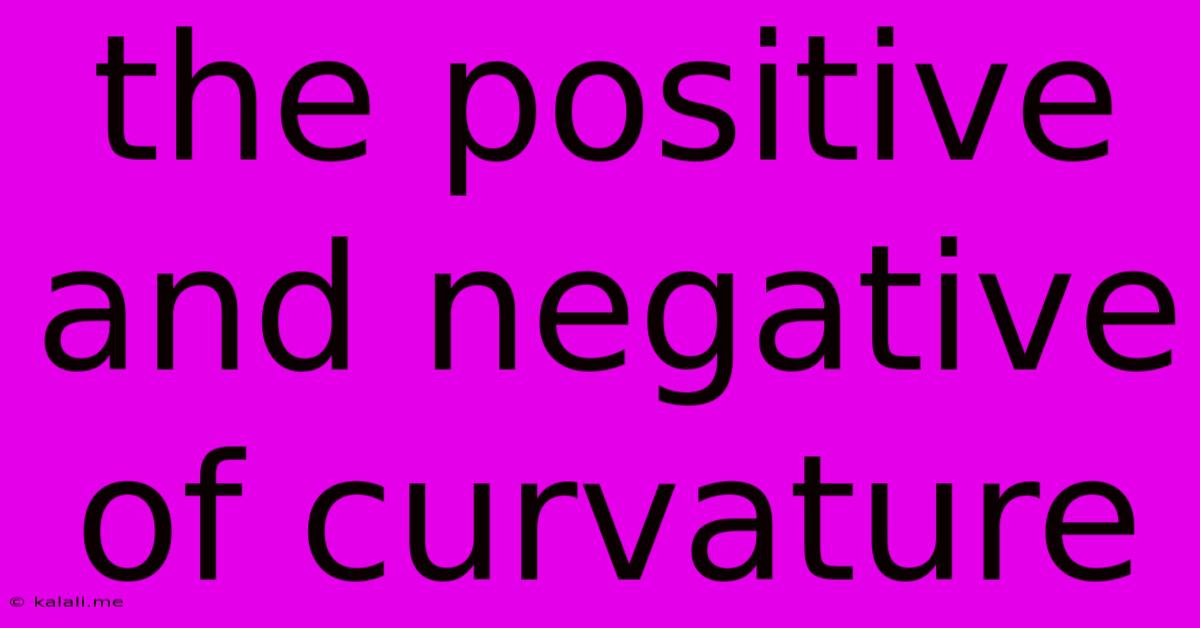The Positive And Negative Of Curvature
Kalali
Jun 11, 2025 · 3 min read

Table of Contents
The Positive and Negative Sides of Curvature: Exploring its Impact in Different Fields
Curvature, a fundamental concept in mathematics and physics, describes the deviation of a curve or surface from being flat. It's a multifaceted concept with significant implications across numerous fields, from the elegance of architectural design to the vastness of the universe. This article delves into both the positive and negative aspects of curvature, examining its influence in various contexts. Understanding curvature's dual nature is crucial for appreciating its profound role in shaping our world.
Understanding Curvature: A Foundation
Before exploring the positive and negative implications, it's vital to grasp the basic concept. Curvature essentially measures how much a curve "bends." A higher curvature indicates a sharper bend, while a lower curvature signifies a gentler curve. A straight line, for instance, has zero curvature. This concept extends to surfaces as well, where Gaussian curvature describes the overall bending at a given point. Positive Gaussian curvature means the surface curves inwards (like a sphere), negative curvature implies it curves outwards like a saddle, and zero curvature indicates a flat surface.
The Positive Aspects of Curvature
Curvature, when harnessed effectively, offers numerous benefits across various domains:
-
Structural Strength and Stability: Curved structures, like arches and domes, exhibit remarkable strength and stability. The inherent geometry distributes weight efficiently, allowing them to withstand significant loads with less material compared to their straight counterparts. This principle is evident in architectural marvels across history and modern engineering.
-
Enhanced Aesthetics and Design: Curvature plays a pivotal role in design, adding elegance and visual appeal. Curved lines create a sense of flow and dynamism, making them aesthetically pleasing in various applications, from furniture and automobiles to building facades and landscape architecture. The smooth transitions and organic forms often evoke a feeling of sophistication and modernity.
-
Improved Aerodynamics and Fluid Dynamics: Curved surfaces are often employed to optimize aerodynamic performance. The curved shape of airplane wings, for example, generates lift by manipulating airflow, enabling flight. Similarly, curved surfaces in hydrodynamics reduce drag in marine vessels and underwater vehicles.
-
Advanced Optical Systems: Curved lenses and mirrors are fundamental components in optical systems, from microscopes and telescopes to cameras and eyeglasses. Their ability to refract and reflect light allows for image formation and manipulation, enabling advancements in imaging technology and scientific research.
-
Data Representation and Analysis: In data science and machine learning, curved manifolds are used to represent high-dimensional data, allowing for more efficient and accurate analysis. Techniques like manifold learning leverage the inherent geometry of curved spaces to uncover hidden patterns and structures in complex datasets.
The Negative Aspects of Curvature
While curvature offers many advantages, it also presents challenges:
-
Increased Complexity in Manufacturing and Construction: Creating curved structures can be more complex and costly than constructing straight ones. Specialized techniques and materials may be required, potentially leading to higher production costs and longer manufacturing times.
-
Stress Concentration and Material Failure: Sharp curves can lead to stress concentration, potentially causing material failure under load. Careful design and material selection are crucial to mitigate this risk, particularly in high-stress applications like bridges and aerospace structures.
-
Difficulties in Assembly and Maintenance: The intricate shapes of curved components can make assembly and maintenance more challenging, requiring specialized tools and expertise. This added complexity can increase labor costs and downtime.
-
Limitations in Certain Applications: In some cases, curvature may be undesirable. For instance, in precision machining, maintaining straightness and flatness is crucial to ensure accuracy and functionality. Deviations from perfect flatness can lead to performance issues and inaccuracies.
-
Computational Challenges: Modeling and simulating curved structures can be computationally demanding, requiring advanced software and significant processing power. This can increase the time and resources needed for design and analysis.
Conclusion
Curvature is a double-edged sword, offering both significant advantages and considerable challenges. Its impact spans diverse fields, from architecture and engineering to data science and optical systems. Understanding the positive and negative aspects of curvature is crucial for effective design, optimization, and problem-solving across various disciplines. The careful consideration of its implications is key to harnessing its power while mitigating potential drawbacks.
Latest Posts
Latest Posts
-
Which Of The Following Is A Monosaccharide
Jun 12, 2025
-
Flexible Manufacturing Systems Can Be Extended
Jun 12, 2025
-
26 Is 65 Of What Number
Jun 12, 2025
-
What Sea Separates Africa From Europe
Jun 12, 2025
-
What Is The Square Root Of 1681
Jun 12, 2025
Related Post
Thank you for visiting our website which covers about The Positive And Negative Of Curvature . We hope the information provided has been useful to you. Feel free to contact us if you have any questions or need further assistance. See you next time and don't miss to bookmark.